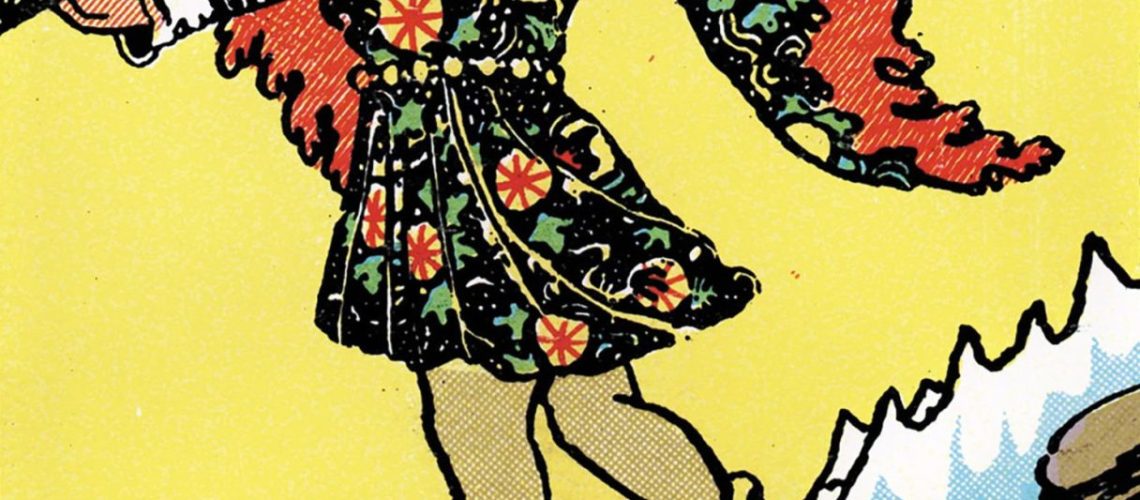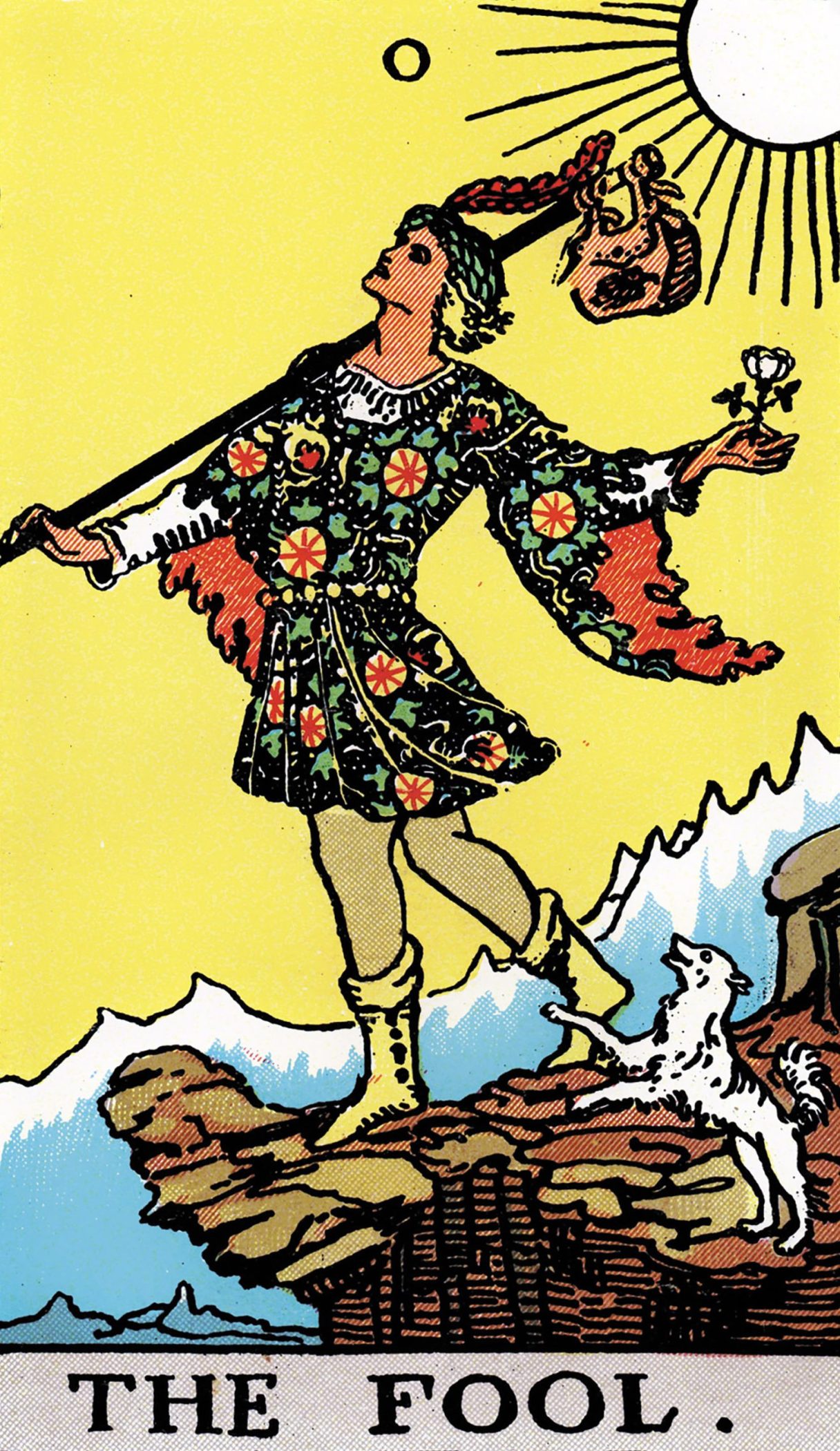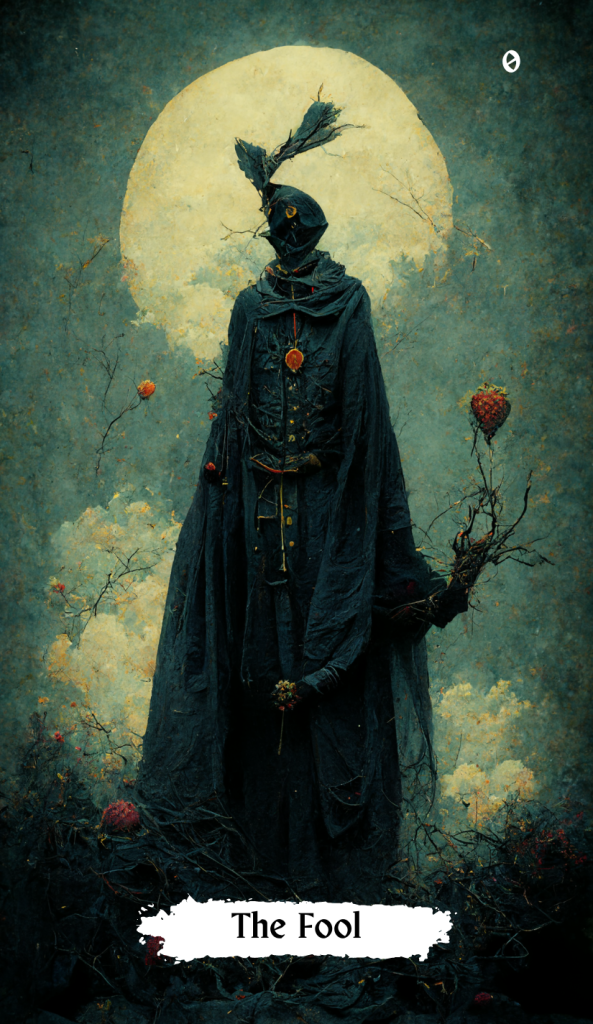
The Fool is one of the most famous Tarot cards. The Fool symbolizes new beginnings, risk-taking, and adventure. This blog post discusses the Fool Tarot card’s symbolism, interpretations, and usefulness in modern tarot readings.
The Fool Tarot card was first utilized as a game rather than a divination tool. Early Italian Tarot decks featured only the Major Arcana, including the Fool.
In early Tarot decks, the Fool was a “wild card” that may be added anytime. The Fool was formally named the 22nd card in the Major Arcana in the 18th century, frequently with a number of 0 or XXII.
In the late 19th and early 20th centuries, the Fool card gained new meaning as the Tarot became more popular as a divinatory tool. In the Rider-Waite-Smith deck, the Fool is a young guy with a bag walking off a cliff with a tiny white dog. Tarot readers instantly recognize this image as the Fool.
The Fool Tarot card symbolizes the soul’s life path, with each Major Arcana card signifying a stage or lesson. The Fool, the first card in the Major Arcana, symbolizes this journey’s infinite possibilities.
The Fool’s position in the Major Arcana affects its relationships with other cards. The Fool bridges the Major and Minor Arcana, connecting the spiritual and ordinary. Each Major Arcana card represents a stage in The Fool’s spiritual awakening and development.
The Fool Tarot card has a long history as a game, but its symbolism and meaning have changed to reflect its position in modern Tarot readings. The Fool, the first Major Arcana card, symbolizes possibility and potential, reminding us that every journey begins with a single step into the unknown.
The Fool Tarot card symbolizes the trickster, jester, and holy fool.
The trickster represents the disorder in many civilizations. Tricksters use their wit and cunning to challenge authority and change things. The Fool, a trickster figure in the Tarot, represents change and inventiveness.
Medieval jesters regularly made political and social comments. Jesters used humor and laughter to criticize the powerful. The Fool Tarot card, like a modern jester, uses comedy and symbolism to explore the human experience.
Holy fools have appeared in various spiritual traditions, including the Fool. The holy fool was a Christian saint who lived in extreme poverty and performed absurd acts or spoke in contradictory riddles. The Fool in the Tarot represents this holy fool character, a divine innocence, and purity that can help us connect with the deeper spiritual qualities of life.
The Fool Tarot card is a complex symbol based on historical and mythical figures. The Fool—as a prankster, jester, or holy fool—invites us to accept the unknown and investigate the universe’s deepest mysteries.

One of the most prominent Tarot decks is the Rider-Waite-Smith, developed by Arthur Edward Waite and drawn by Pamela Colman Smith. This deck’s Fool card is rich with symbolism.
The Rider-Waite-Smith Fool card depicts a young guy gazing upwards from a cliff. He has a little bundle on his shoulder and a hand outstretched. He appears to be taking a step forward, but his foot is perched on the precipice, indicating that he is not yet ready to commit to the voyage.
This card has numerous interesting symbols and details. The Fool’s dog depicts his animal tendencies and the wild powers of nature, while the white rose in his lapel symbolizes purity and innocence. The Fool’s voyage will be hampered by the mountains in the distance and the sun in the upper right corner, which represents consciousness.
However, the Rider-Waite-Smith Fool card’s Fool at the edge of the cliff is stunning. This represents the threshold between safety and risk. The Fool must decide whether to leave or stay. This striking metaphor illustrates the universal fact that we are all on a path of self-discovery and growth.
The Rider-Waite-Smith Fool Tarot card is full of symbolism and meaning. From the Fool’s location on the cliff to the symbols and nuances throughout the painting, this card is a strong reminder of our journey and our boundless potential.
The Fool’s relationship with 0 is striking. The Fool is the first card in the Major Arcana, however, it is numbered 0. The Fool symbolizes the start of a new journey, a time of boundless opportunity before any action is performed.
Zero symbolizes this potential and openness. It symbolizes the infinite, unmanifested, and nothingness. The Fool invites us to enter the unknown and discover our full potential.
In many spiritual systems, 0 has a deeper meaning. In Hinduism, 0 represents Brahman, the ultimate reality that underlies all existence. In Buddhism, 0 denotes shunyata, or emptiness, the idea that all phenomena are ultimately empty of fundamental existence.
The Fool’s number 0 symbolizes emptiness and potentiality in the Tarot. The Fool represents boundless potential before any form or organization is developed. It reminds us that we may build our own destinies and shape our lives.
The Fool Tarot card reminds us of the power of the present and our boundless potential. The Fool invites us to brave the unknown and accept life’s mystery. The Fool’s Trickster archetype and Tarot readings
The Fool Tarot card has been interpreted several ways throughout history. Traditional card interpretations, both upright and inverted, are listed here.

The Fool, the first Major Arcana card, influences the interpretation of the other Tarot cards. The Fool’s presence can affect other cards’ meanings in these ways:
The Fool affects the interpretation of other Tarot cards. The Fool, the first Major Arcana card, symbolizes a new start and endless possibilities. The Fool can indicate that the querent is about to start a new chapter in their life.
The Fool may also suggest that the querent be spontaneous, risk-taking, and open to new experiences. It inspires the querent to follow their instincts and try new things. The Fool symbolizes innocence, wonder, and childlike curiosity, and its appearance in a reading may indicate that the querent must draw on these attributes to succeed.
The Fool inspires other Tarot cards with new beginnings, growth, and change. It can encourage the querent to take risks, embrace uncertainty, and trust the road ahead.
The Fool Tarot card is a sophisticated and diverse figure that fascinates and inspires Tarot readers everywhere. grasp the Fool card’s symbolism, interpretations, and application will expand your grasp of the Tarot and help you gain new life insights.